Strategic Analysis and Comparison of Food Industry Leaders
VerifiedAdded on 2022/08/26
|10
|1444
|21
Report
AI Summary
This report provides a comparative analysis of three major players in the food and beverage industry: Nestle, Tyson Foods, and ConAgra Foods. The analysis focuses on their marketing objectives, including strategies for market growth, brand positioning, and customer engagement. It examines their financial objectives, such as cost-saving strategies, shareholder returns, and access to financial markets. The report also delves into their strategy development, encompassing product differentiation, acquisition strategies, and competitive positioning. Furthermore, the report compares the positioning of their products within the market, considering factors such as price and quality. The conclusion summarizes the key findings and highlights the strategic approaches each company employs to navigate the challenges and opportunities within the dynamic food and beverage sector. The report uses academic research approaches and APA citation format with references from academic books, journal articles, and credible online sources.
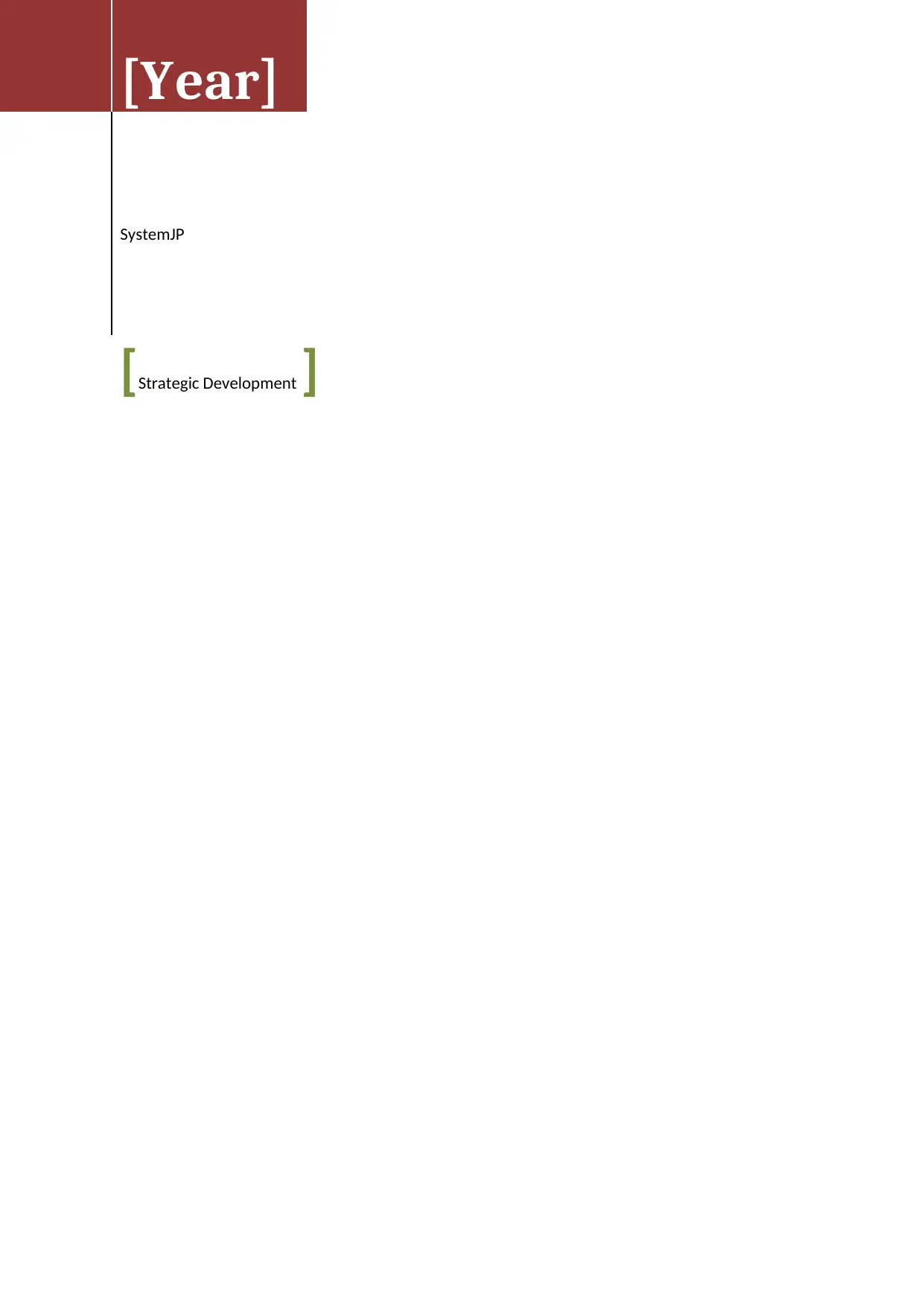
[Strategic Development ]
[Year]
SystemJP
[Year]
SystemJP
Paraphrase This Document
Need a fresh take? Get an instant paraphrase of this document with our AI Paraphraser
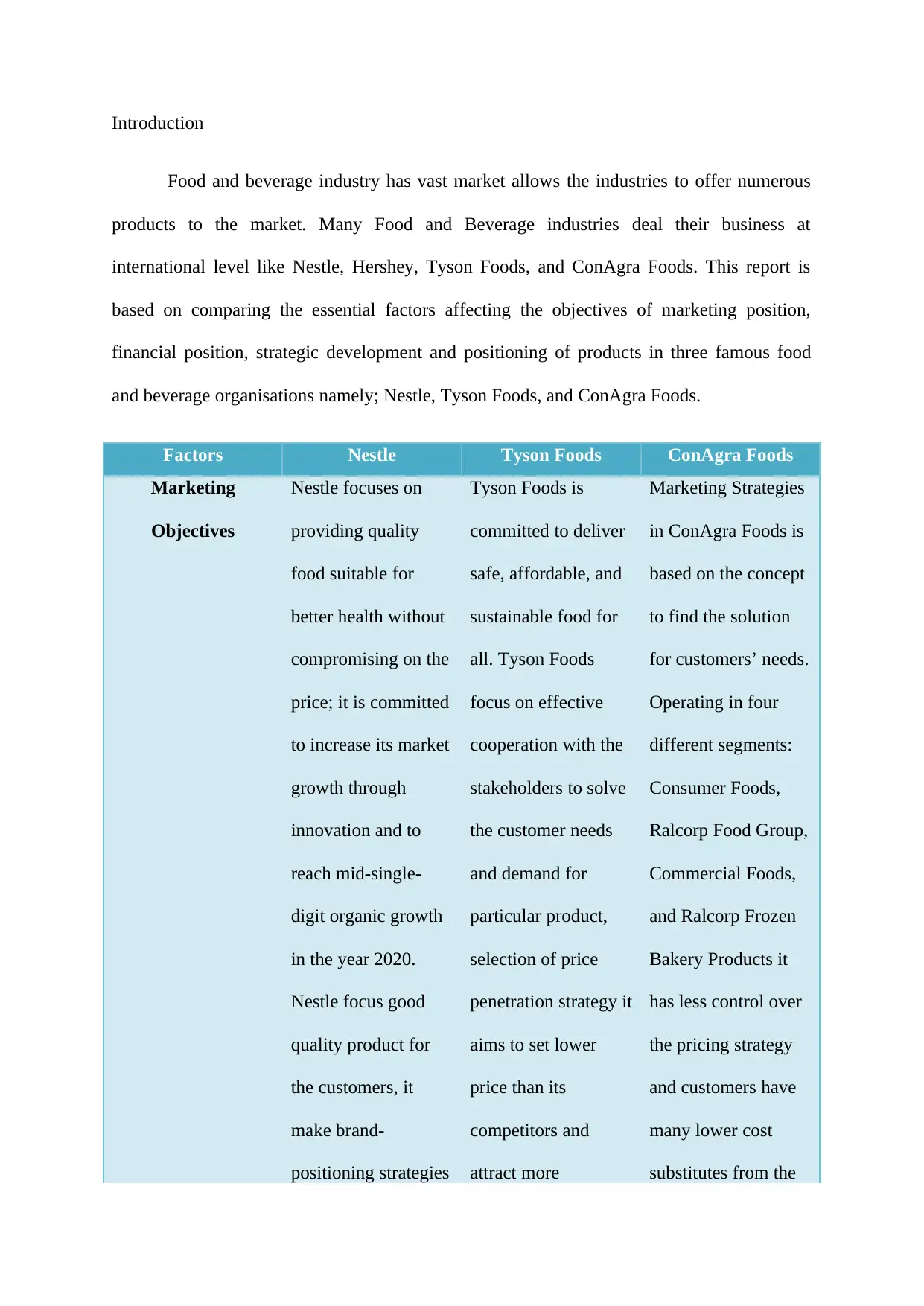
Introduction
Food and beverage industry has vast market allows the industries to offer numerous
products to the market. Many Food and Beverage industries deal their business at
international level like Nestle, Hershey, Tyson Foods, and ConAgra Foods. This report is
based on comparing the essential factors affecting the objectives of marketing position,
financial position, strategic development and positioning of products in three famous food
and beverage organisations namely; Nestle, Tyson Foods, and ConAgra Foods.
Factors Nestle Tyson Foods ConAgra Foods
Marketing
Objectives
Nestle focuses on
providing quality
food suitable for
better health without
compromising on the
price; it is committed
to increase its market
growth through
innovation and to
reach mid-single-
digit organic growth
in the year 2020.
Nestle focus good
quality product for
the customers, it
make brand-
positioning strategies
Tyson Foods is
committed to deliver
safe, affordable, and
sustainable food for
all. Tyson Foods
focus on effective
cooperation with the
stakeholders to solve
the customer needs
and demand for
particular product,
selection of price
penetration strategy it
aims to set lower
price than its
competitors and
attract more
Marketing Strategies
in ConAgra Foods is
based on the concept
to find the solution
for customers’ needs.
Operating in four
different segments:
Consumer Foods,
Ralcorp Food Group,
Commercial Foods,
and Ralcorp Frozen
Bakery Products it
has less control over
the pricing strategy
and customers have
many lower cost
substitutes from the
Food and beverage industry has vast market allows the industries to offer numerous
products to the market. Many Food and Beverage industries deal their business at
international level like Nestle, Hershey, Tyson Foods, and ConAgra Foods. This report is
based on comparing the essential factors affecting the objectives of marketing position,
financial position, strategic development and positioning of products in three famous food
and beverage organisations namely; Nestle, Tyson Foods, and ConAgra Foods.
Factors Nestle Tyson Foods ConAgra Foods
Marketing
Objectives
Nestle focuses on
providing quality
food suitable for
better health without
compromising on the
price; it is committed
to increase its market
growth through
innovation and to
reach mid-single-
digit organic growth
in the year 2020.
Nestle focus good
quality product for
the customers, it
make brand-
positioning strategies
Tyson Foods is
committed to deliver
safe, affordable, and
sustainable food for
all. Tyson Foods
focus on effective
cooperation with the
stakeholders to solve
the customer needs
and demand for
particular product,
selection of price
penetration strategy it
aims to set lower
price than its
competitors and
attract more
Marketing Strategies
in ConAgra Foods is
based on the concept
to find the solution
for customers’ needs.
Operating in four
different segments:
Consumer Foods,
Ralcorp Food Group,
Commercial Foods,
and Ralcorp Frozen
Bakery Products it
has less control over
the pricing strategy
and customers have
many lower cost
substitutes from the
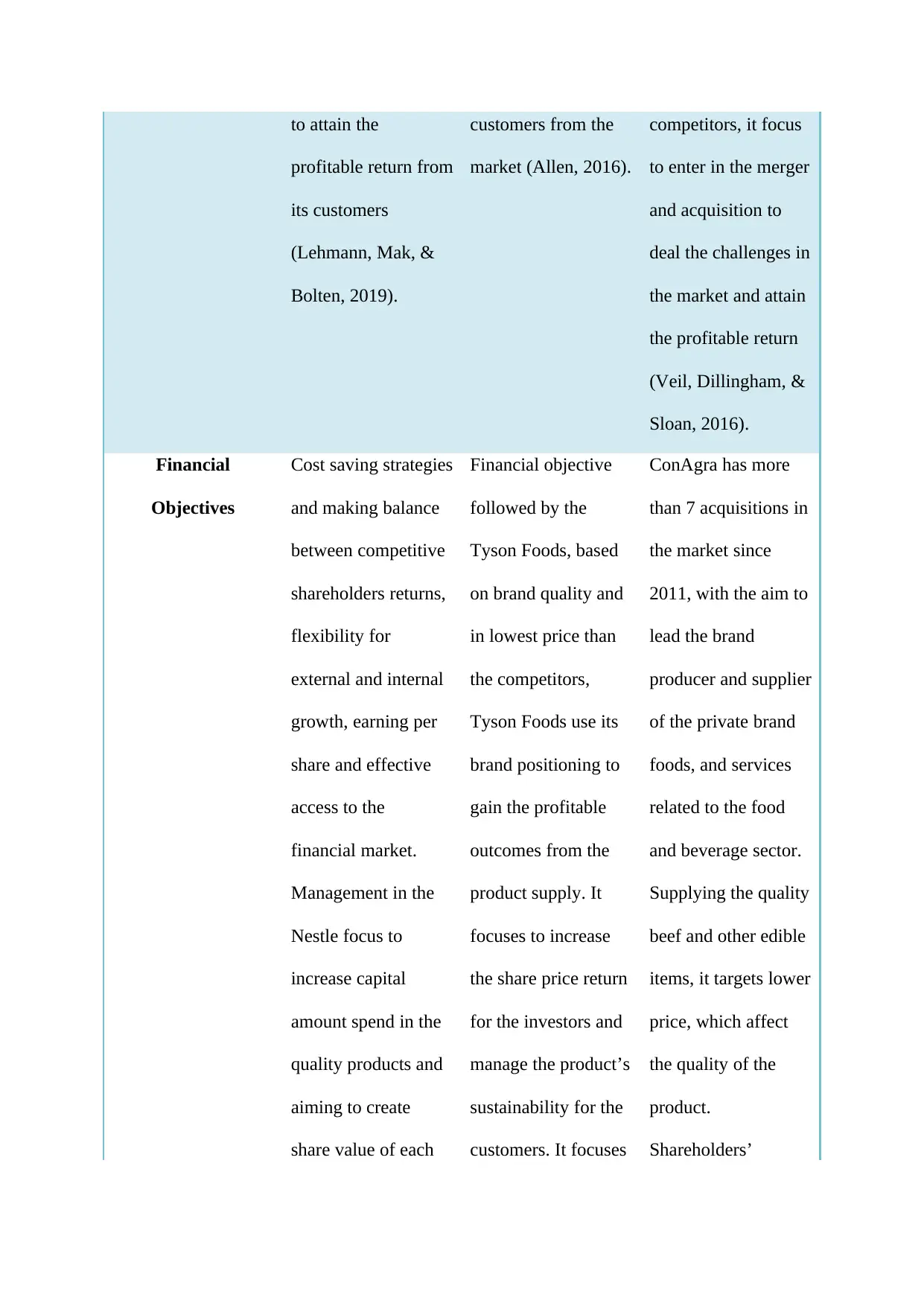
to attain the
profitable return from
its customers
(Lehmann, Mak, &
Bolten, 2019).
customers from the
market (Allen, 2016).
competitors, it focus
to enter in the merger
and acquisition to
deal the challenges in
the market and attain
the profitable return
(Veil, Dillingham, &
Sloan, 2016).
Financial
Objectives
Cost saving strategies
and making balance
between competitive
shareholders returns,
flexibility for
external and internal
growth, earning per
share and effective
access to the
financial market.
Management in the
Nestle focus to
increase capital
amount spend in the
quality products and
aiming to create
share value of each
Financial objective
followed by the
Tyson Foods, based
on brand quality and
in lowest price than
the competitors,
Tyson Foods use its
brand positioning to
gain the profitable
outcomes from the
product supply. It
focuses to increase
the share price return
for the investors and
manage the product’s
sustainability for the
customers. It focuses
ConAgra has more
than 7 acquisitions in
the market since
2011, with the aim to
lead the brand
producer and supplier
of the private brand
foods, and services
related to the food
and beverage sector.
Supplying the quality
beef and other edible
items, it targets lower
price, which affect
the quality of the
product.
Shareholders’
profitable return from
its customers
(Lehmann, Mak, &
Bolten, 2019).
customers from the
market (Allen, 2016).
competitors, it focus
to enter in the merger
and acquisition to
deal the challenges in
the market and attain
the profitable return
(Veil, Dillingham, &
Sloan, 2016).
Financial
Objectives
Cost saving strategies
and making balance
between competitive
shareholders returns,
flexibility for
external and internal
growth, earning per
share and effective
access to the
financial market.
Management in the
Nestle focus to
increase capital
amount spend in the
quality products and
aiming to create
share value of each
Financial objective
followed by the
Tyson Foods, based
on brand quality and
in lowest price than
the competitors,
Tyson Foods use its
brand positioning to
gain the profitable
outcomes from the
product supply. It
focuses to increase
the share price return
for the investors and
manage the product’s
sustainability for the
customers. It focuses
ConAgra has more
than 7 acquisitions in
the market since
2011, with the aim to
lead the brand
producer and supplier
of the private brand
foods, and services
related to the food
and beverage sector.
Supplying the quality
beef and other edible
items, it targets lower
price, which affect
the quality of the
product.
Shareholders’
⊘ This is a preview!⊘
Do you want full access?
Subscribe today to unlock all pages.

Trusted by 1+ million students worldwide
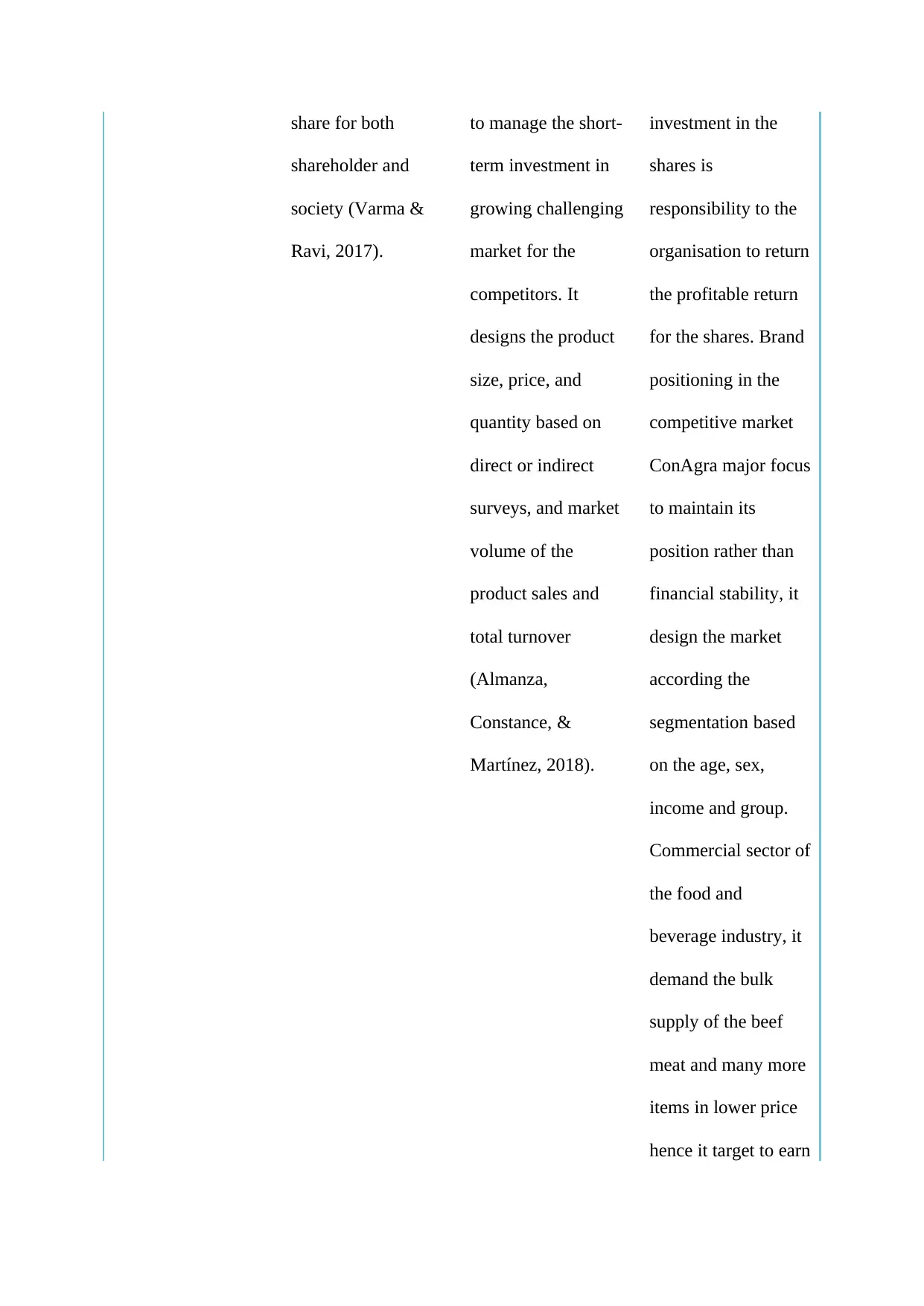
share for both
shareholder and
society (Varma &
Ravi, 2017).
to manage the short-
term investment in
growing challenging
market for the
competitors. It
designs the product
size, price, and
quantity based on
direct or indirect
surveys, and market
volume of the
product sales and
total turnover
(Almanza,
Constance, &
Martínez, 2018).
investment in the
shares is
responsibility to the
organisation to return
the profitable return
for the shares. Brand
positioning in the
competitive market
ConAgra major focus
to maintain its
position rather than
financial stability, it
design the market
according the
segmentation based
on the age, sex,
income and group.
Commercial sector of
the food and
beverage industry, it
demand the bulk
supply of the beef
meat and many more
items in lower price
hence it target to earn
shareholder and
society (Varma &
Ravi, 2017).
to manage the short-
term investment in
growing challenging
market for the
competitors. It
designs the product
size, price, and
quantity based on
direct or indirect
surveys, and market
volume of the
product sales and
total turnover
(Almanza,
Constance, &
Martínez, 2018).
investment in the
shares is
responsibility to the
organisation to return
the profitable return
for the shares. Brand
positioning in the
competitive market
ConAgra major focus
to maintain its
position rather than
financial stability, it
design the market
according the
segmentation based
on the age, sex,
income and group.
Commercial sector of
the food and
beverage industry, it
demand the bulk
supply of the beef
meat and many more
items in lower price
hence it target to earn
Paraphrase This Document
Need a fresh take? Get an instant paraphrase of this document with our AI Paraphraser
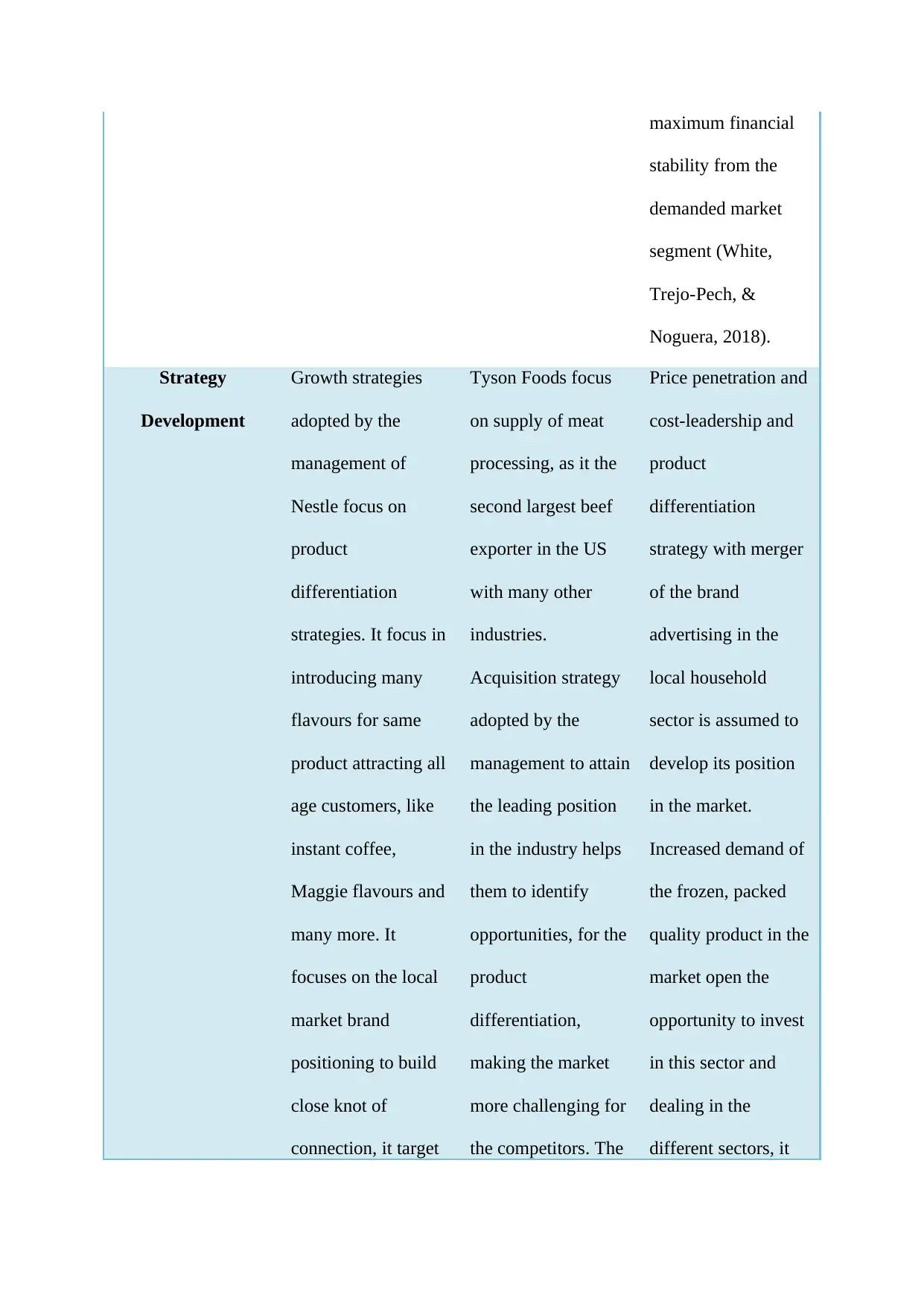
maximum financial
stability from the
demanded market
segment (White,
Trejo-Pech, &
Noguera, 2018).
Strategy
Development
Growth strategies
adopted by the
management of
Nestle focus on
product
differentiation
strategies. It focus in
introducing many
flavours for same
product attracting all
age customers, like
instant coffee,
Maggie flavours and
many more. It
focuses on the local
market brand
positioning to build
close knot of
connection, it target
Tyson Foods focus
on supply of meat
processing, as it the
second largest beef
exporter in the US
with many other
industries.
Acquisition strategy
adopted by the
management to attain
the leading position
in the industry helps
them to identify
opportunities, for the
product
differentiation,
making the market
more challenging for
the competitors. The
Price penetration and
cost-leadership and
product
differentiation
strategy with merger
of the brand
advertising in the
local household
sector is assumed to
develop its position
in the market.
Increased demand of
the frozen, packed
quality product in the
market open the
opportunity to invest
in this sector and
dealing in the
different sectors, it
stability from the
demanded market
segment (White,
Trejo-Pech, &
Noguera, 2018).
Strategy
Development
Growth strategies
adopted by the
management of
Nestle focus on
product
differentiation
strategies. It focus in
introducing many
flavours for same
product attracting all
age customers, like
instant coffee,
Maggie flavours and
many more. It
focuses on the local
market brand
positioning to build
close knot of
connection, it target
Tyson Foods focus
on supply of meat
processing, as it the
second largest beef
exporter in the US
with many other
industries.
Acquisition strategy
adopted by the
management to attain
the leading position
in the industry helps
them to identify
opportunities, for the
product
differentiation,
making the market
more challenging for
the competitors. The
Price penetration and
cost-leadership and
product
differentiation
strategy with merger
of the brand
advertising in the
local household
sector is assumed to
develop its position
in the market.
Increased demand of
the frozen, packed
quality product in the
market open the
opportunity to invest
in this sector and
dealing in the
different sectors, it
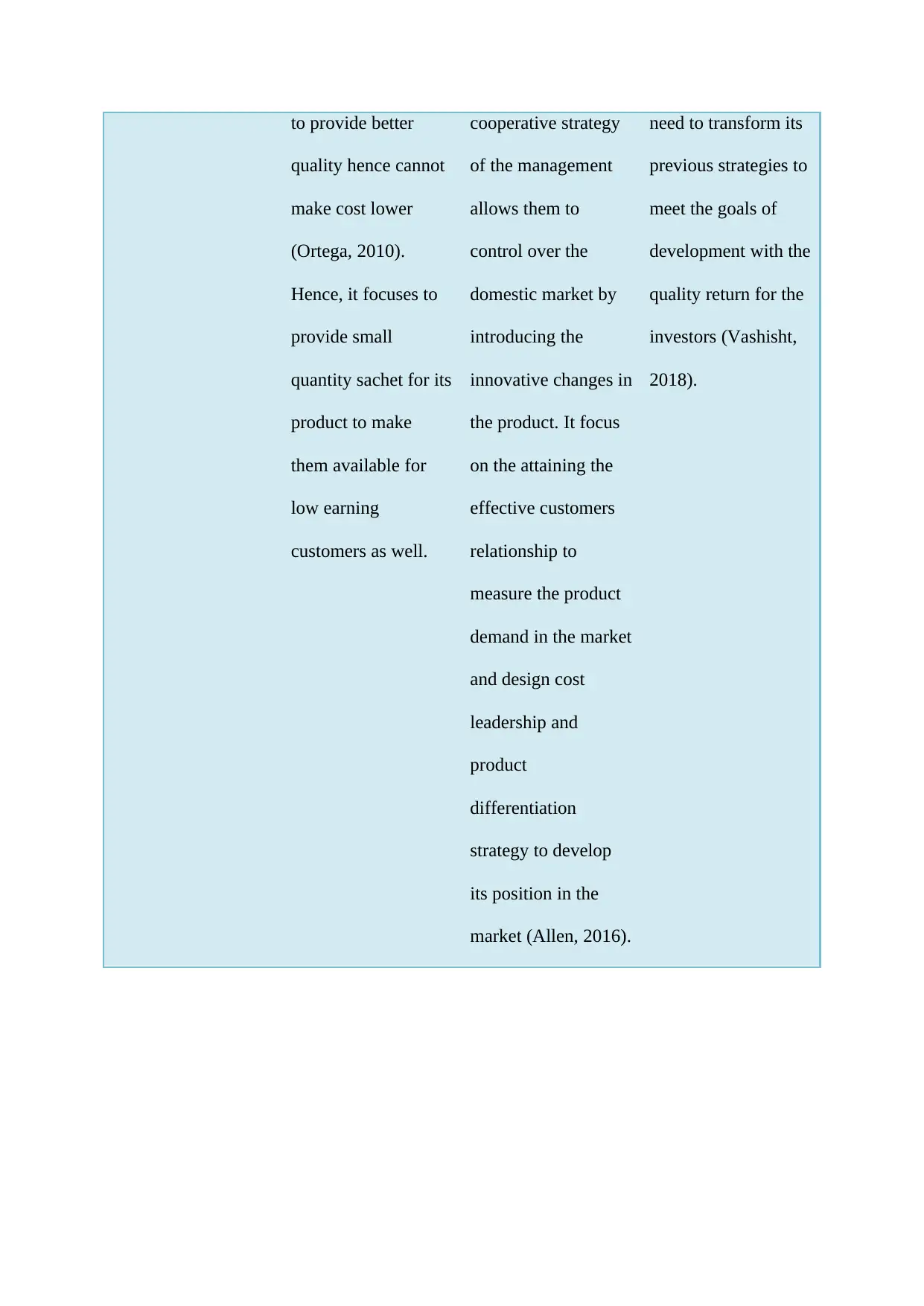
to provide better
quality hence cannot
make cost lower
(Ortega, 2010).
Hence, it focuses to
provide small
quantity sachet for its
product to make
them available for
low earning
customers as well.
cooperative strategy
of the management
allows them to
control over the
domestic market by
introducing the
innovative changes in
the product. It focus
on the attaining the
effective customers
relationship to
measure the product
demand in the market
and design cost
leadership and
product
differentiation
strategy to develop
its position in the
market (Allen, 2016).
need to transform its
previous strategies to
meet the goals of
development with the
quality return for the
investors (Vashisht,
2018).
quality hence cannot
make cost lower
(Ortega, 2010).
Hence, it focuses to
provide small
quantity sachet for its
product to make
them available for
low earning
customers as well.
cooperative strategy
of the management
allows them to
control over the
domestic market by
introducing the
innovative changes in
the product. It focus
on the attaining the
effective customers
relationship to
measure the product
demand in the market
and design cost
leadership and
product
differentiation
strategy to develop
its position in the
market (Allen, 2016).
need to transform its
previous strategies to
meet the goals of
development with the
quality return for the
investors (Vashisht,
2018).
⊘ This is a preview!⊘
Do you want full access?
Subscribe today to unlock all pages.

Trusted by 1+ million students worldwide
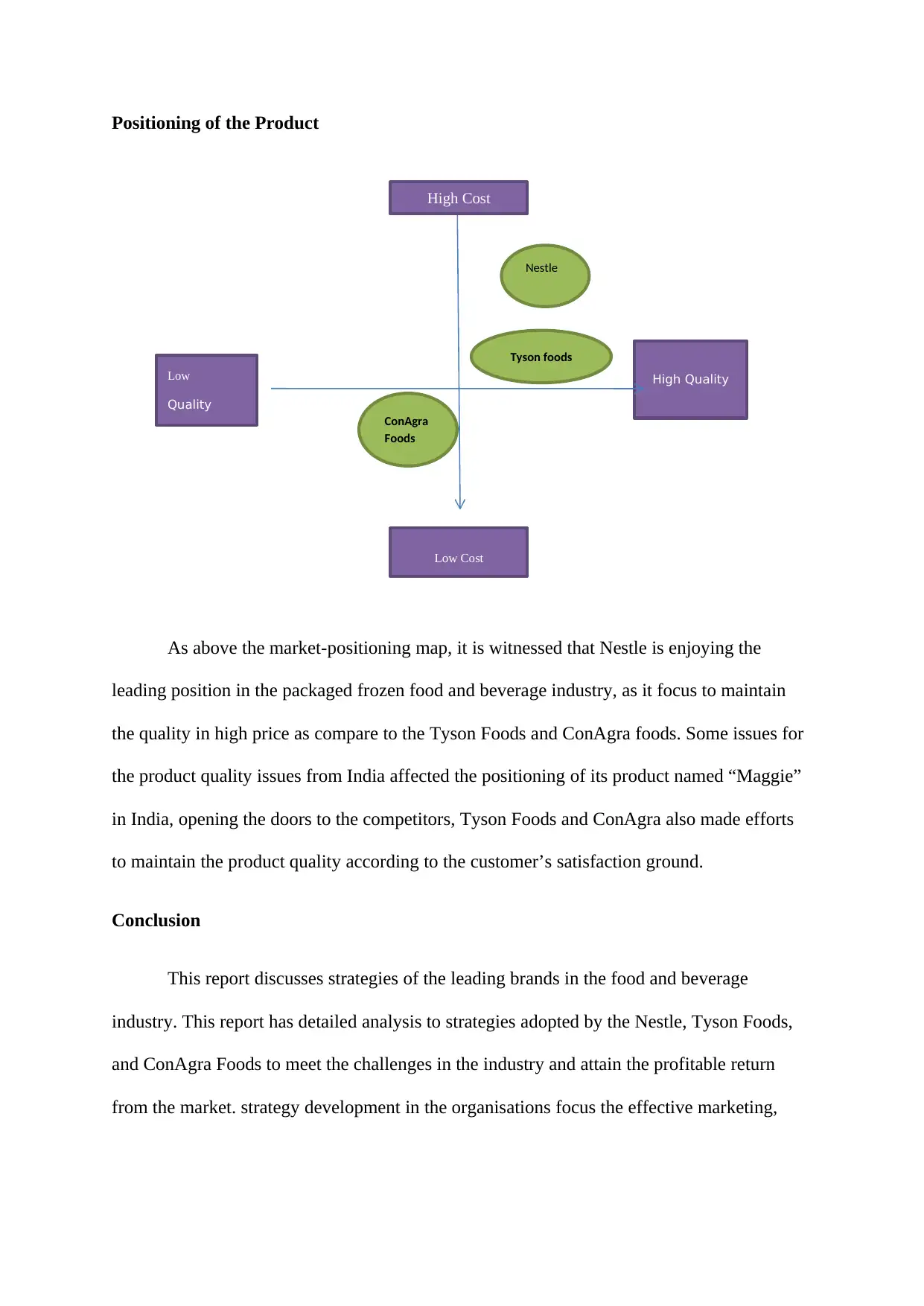
Positioning of the Product
As above the market-positioning map, it is witnessed that Nestle is enjoying the
leading position in the packaged frozen food and beverage industry, as it focus to maintain
the quality in high price as compare to the Tyson Foods and ConAgra foods. Some issues for
the product quality issues from India affected the positioning of its product named “Maggie”
in India, opening the doors to the competitors, Tyson Foods and ConAgra also made efforts
to maintain the product quality according to the customer’s satisfaction ground.
Conclusion
This report discusses strategies of the leading brands in the food and beverage
industry. This report has detailed analysis to strategies adopted by the Nestle, Tyson Foods,
and ConAgra Foods to meet the challenges in the industry and attain the profitable return
from the market. strategy development in the organisations focus the effective marketing,
High Cost
High Quality
Nestle
Tyson foods
Low
Quality
ConAgra
Foods
Low Cost
As above the market-positioning map, it is witnessed that Nestle is enjoying the
leading position in the packaged frozen food and beverage industry, as it focus to maintain
the quality in high price as compare to the Tyson Foods and ConAgra foods. Some issues for
the product quality issues from India affected the positioning of its product named “Maggie”
in India, opening the doors to the competitors, Tyson Foods and ConAgra also made efforts
to maintain the product quality according to the customer’s satisfaction ground.
Conclusion
This report discusses strategies of the leading brands in the food and beverage
industry. This report has detailed analysis to strategies adopted by the Nestle, Tyson Foods,
and ConAgra Foods to meet the challenges in the industry and attain the profitable return
from the market. strategy development in the organisations focus the effective marketing,
High Cost
High Quality
Nestle
Tyson foods
Low
Quality
ConAgra
Foods
Low Cost
Paraphrase This Document
Need a fresh take? Get an instant paraphrase of this document with our AI Paraphraser
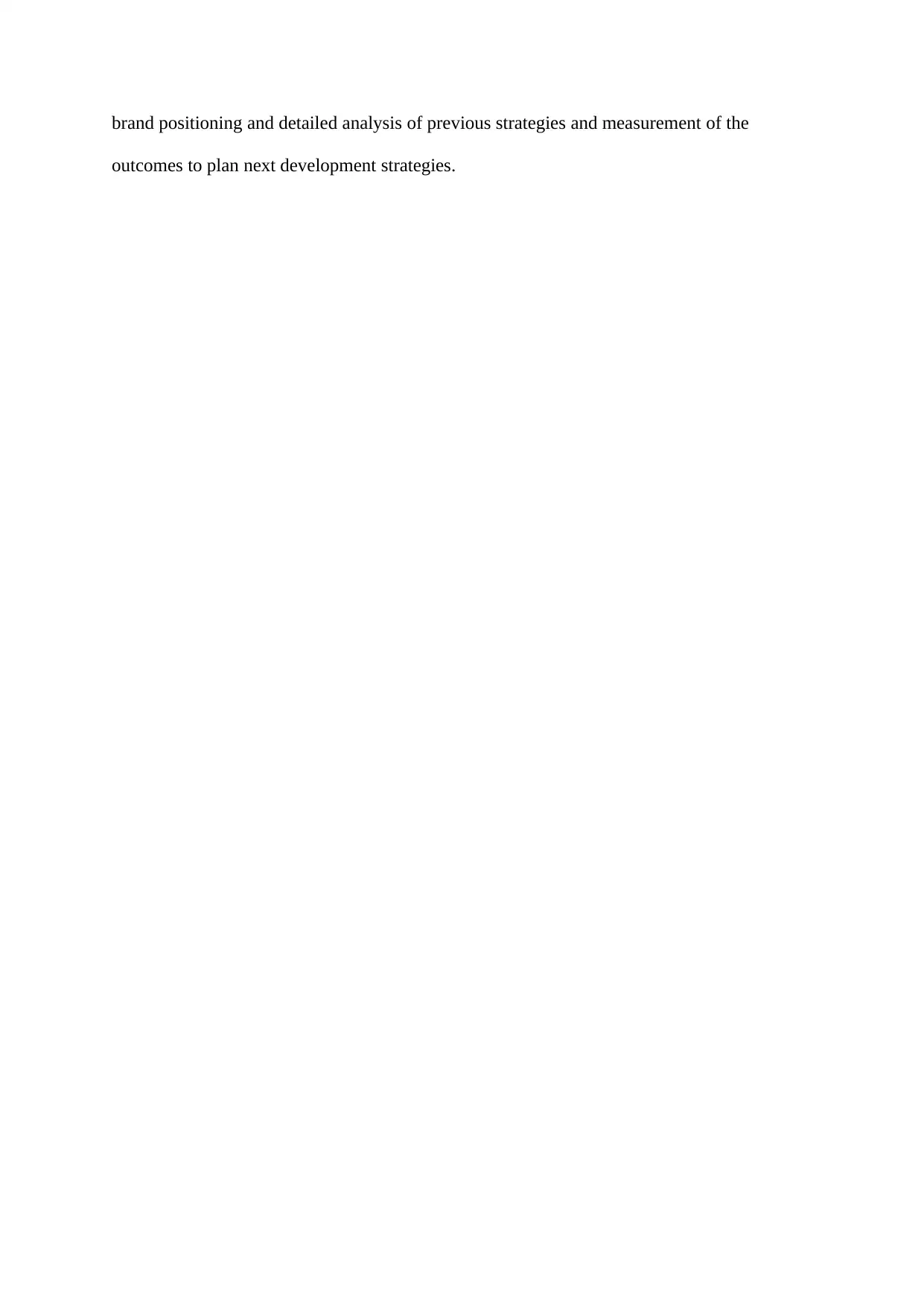
brand positioning and detailed analysis of previous strategies and measurement of the
outcomes to plan next development strategies.
outcomes to plan next development strategies.
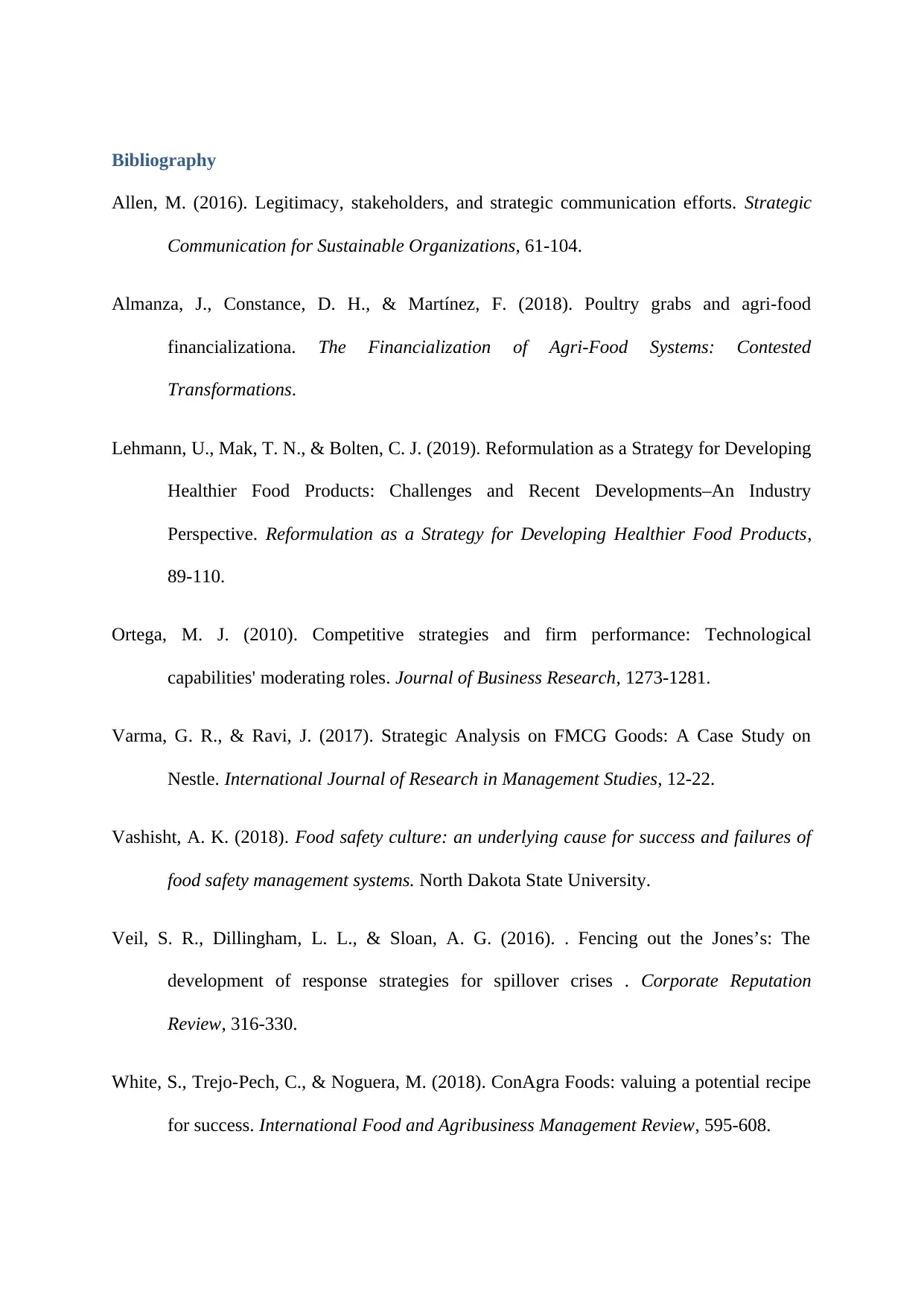
Bibliography
Allen, M. (2016). Legitimacy, stakeholders, and strategic communication efforts. Strategic
Communication for Sustainable Organizations, 61-104.
Almanza, J., Constance, D. H., & Martínez, F. (2018). Poultry grabs and agri-food
financializationa. The Financialization of Agri-Food Systems: Contested
Transformations.
Lehmann, U., Mak, T. N., & Bolten, C. J. (2019). Reformulation as a Strategy for Developing
Healthier Food Products: Challenges and Recent Developments–An Industry
Perspective. Reformulation as a Strategy for Developing Healthier Food Products,
89-110.
Ortega, M. J. (2010). Competitive strategies and firm performance: Technological
capabilities' moderating roles. Journal of Business Research, 1273-1281.
Varma, G. R., & Ravi, J. (2017). Strategic Analysis on FMCG Goods: A Case Study on
Nestle. International Journal of Research in Management Studies, 12-22.
Vashisht, A. K. (2018). Food safety culture: an underlying cause for success and failures of
food safety management systems. North Dakota State University.
Veil, S. R., Dillingham, L. L., & Sloan, A. G. (2016). . Fencing out the Jones’s: The
development of response strategies for spillover crises . Corporate Reputation
Review, 316-330.
White, S., Trejo-Pech, C., & Noguera, M. (2018). ConAgra Foods: valuing a potential recipe
for success. International Food and Agribusiness Management Review, 595-608.
Allen, M. (2016). Legitimacy, stakeholders, and strategic communication efforts. Strategic
Communication for Sustainable Organizations, 61-104.
Almanza, J., Constance, D. H., & Martínez, F. (2018). Poultry grabs and agri-food
financializationa. The Financialization of Agri-Food Systems: Contested
Transformations.
Lehmann, U., Mak, T. N., & Bolten, C. J. (2019). Reformulation as a Strategy for Developing
Healthier Food Products: Challenges and Recent Developments–An Industry
Perspective. Reformulation as a Strategy for Developing Healthier Food Products,
89-110.
Ortega, M. J. (2010). Competitive strategies and firm performance: Technological
capabilities' moderating roles. Journal of Business Research, 1273-1281.
Varma, G. R., & Ravi, J. (2017). Strategic Analysis on FMCG Goods: A Case Study on
Nestle. International Journal of Research in Management Studies, 12-22.
Vashisht, A. K. (2018). Food safety culture: an underlying cause for success and failures of
food safety management systems. North Dakota State University.
Veil, S. R., Dillingham, L. L., & Sloan, A. G. (2016). . Fencing out the Jones’s: The
development of response strategies for spillover crises . Corporate Reputation
Review, 316-330.
White, S., Trejo-Pech, C., & Noguera, M. (2018). ConAgra Foods: valuing a potential recipe
for success. International Food and Agribusiness Management Review, 595-608.
⊘ This is a preview!⊘
Do you want full access?
Subscribe today to unlock all pages.

Trusted by 1+ million students worldwide

1 out of 10
Related Documents
Your All-in-One AI-Powered Toolkit for Academic Success.
+13062052269
info@desklib.com
Available 24*7 on WhatsApp / Email
![[object Object]](/_next/static/media/star-bottom.7253800d.svg)
Unlock your academic potential
Copyright © 2020–2025 A2Z Services. All Rights Reserved. Developed and managed by ZUCOL.





